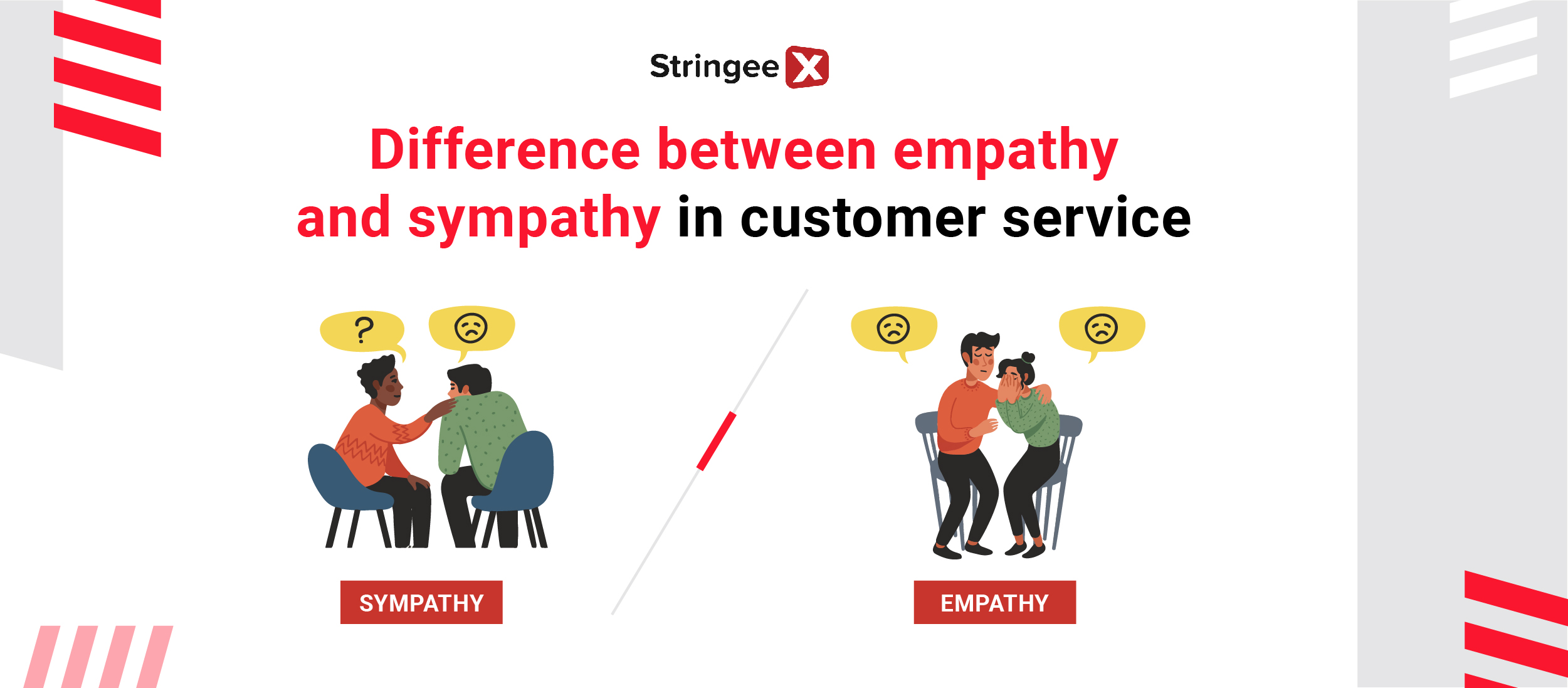Intro
Many people use sympathy and empathy interchangeably. However, the two terms are worlds apart in customer service. Each ability, when used appropriately, can take customer satisfaction to the next level. Let’s discover the difference between empathy and sympathy in customer service to better apply them.
What Is The Difference Between Empathy And Sympathy In Customer Service
Key Characteristics
Simply put, empathy is understanding how others feel in a certain circumstance, whether negative or positive. You are empathetic when you actively listen to others’ stories. You also pay attention to their body language and nuances to gain a clearer perspective. With a shared feeling and viewpoint, you can make more tailored and relevant decisions without judgement.
According to our research, empathy blurs the gap between clients and businesses, as we listen to and treat everyone equally, avoiding unethical behaviour and discrimination. This ability helps build rapport with your customers, reinforcing your brand image over time.
On the other hand, when you feel sorry or pity for others’ misfortune, you’re expressing your sympathy. You might or might not understand their feelings, but you somehow feel bad for what they’ve been through. It can be said that empathy is a step up from sympathy when you really put yourself into others’ situations and perceive things through their eyes.
In terms of customer service, sympathy shows you do care about customers’ concerns, while empathy demonstrates your understanding of their situations, perspectives, and feelings. A solution based on sympathy might stem from your perspective. However, a decision rooted in empathy considers the customers’ feelings and points of view.
Empathy is walking in others’ shoes. Source: Flickr
Emotional Engagement
As seen from the key characteristics of empathy and sympathy, these two abilities deliver different levels of emotional engagement. Sympathy is a superficial emotion, meaning you acknowledge customers’ concerns but don’t fully grasp their feelings.
Meanwhile, empathy requires a deeper emotional connection, meaning you must share your experiences and feelings. It’s like stepping in their shoes and experiencing what they’re suffering.
Impact On Customers’ Experience
With distinct characteristics and levels of emotional engagement, the appliance of empathy and sympathy can set your customer service apart from competitors. If sympathy demonstrates your listening skills and how much you care for customers’ problems, empathy is a testament to your interpersonal skills and commitment to addressing their concerns.
When applied appropriately, these abilities promote customer satisfaction and loyalty.
An Example
Theory aside, let’s take an example to better clarify how empathy and sympathy differ.
Let’s say a customer comes in to complain about a defective product. A response rooted in sympathy would be, “I’m so sorry for the defect.” And that’s it. Your answer stops at showing your pity for the inconvenience to the customer.
However, an empathetic customer service agent would say, “I understand how frustrating and disappointing it must be. Let’s see what we can do for you!” In this case, you not only express your understanding of their situation but also your willingness to offer the best solution.
Which Is Better, Empathy Or Sympathy?
Excellent customer service requires you to go the extra mile, and empathy is a great tool to take you there. It bridges the gap between clients and businesses by feeling customers’ concerns and emotions. Such a deeper understanding empowers you to offer solutions that resonate with customers the most.
Meanwhile, when people around us go through tough times, feeling sorry for them is just an everyday social gesture. So, sympathy is simply a common social norm. It won’t help build a deep connection between customers and companies.
That’s why we would say empathy makes a huge difference between poor and great customer service.
How To Demonstrate Empathy In Customer Service
Use Meaningful Key Phrases
Pay attention to some key phrases to express your empathy. Source: Wikimedia Commons
The right word choice adds tons of weight to your statements. A good rule of thumb is to stick with reassuring and positive language. Sometimes, customers only want to feel heard and cared for, so try saying these key phrases to hit the right spot:
- I understand what you are experiencing/how disappointing/frustrating it must be for you.
- I would also be disappointed/frustrated if the same happened to me.
- I can relate to what you’re experiencing.
- I can completely imagine how you feel.
You can play around with the language as long as it stems from your genuine care and understanding.
Let Them Vent
Most, if not all, customers express anger when contacting the customer service department. Dealing with hundreds of upset customers daily can be exhausting and distressing. However, as a customer service agent, you must always prepare for their explosive emotions.
Keep listening actively until they’ve vented all their pent-up anger. Once they calm down, they can absorb what you’re saying more easily. Sometimes, being a good listener is all it takes to show empathy to your customers.
Stay Positive And Be Patient
Patience is the cornerstone of empathy in customer service. A customer can come in and talk for hours on end about their problems. Their burst of anger can last longer than expected. But even when these happen, always prove yourself a good listener with a positive attitude.
Maintain eye contact and ask clarifying questions to show you care about their concerns. Also, keep your voice calm and friendly and use positive language when talking to customers. If overwhelmed, try taking a 5-minute break, walking around the office or doing some mild exercise to clear your mind.
If overworked, an automated call centre will be a great right-hand man to keep your customers content.
Overcome Your Biases
Preconceptions about someone can influence how you approach their issues in a bad way. For example, when you see a furious man walk in and yell loudly at you, you might assume that he’s rude. This might more or less affect your decision later.
Before handling any case, shrug off all the biases and negative impressions about customers. Treat them equally and give unbiased solutions to stay true to your empathic strategy.
For more tips on practising empathy in customer service, click here!
Don’t let your biases decide your solutions. Source: Pxhere
Are Sympathy and Empathy The Same As Compassion?
Sympathy is when you feel sorry for the pain or misfortune of others but don’t really understand their feelings. It’s about acknowledging their tough times and offering support without fully stepping into their world. When a customer complains about a late delivery, you feel sorry for them and offer a listening ear. That’s sympathy.
On the other hand, empathy is stepping in someone else’s shoes. You truly understand and share their feelings. It’s like feeling their joy or sorrow as your own. This is when you form a deep connection with customers.
Compassion is a step up from empathy. It’s not just about understanding customers’ concerns but taking action to solve them. For instance, instead of just saying, “I understand your disappointment,” you also offer some discounts or freebies as a gesture of apology to the customer.
To sum up, sympathy is about understanding, empathy is about feeling, and compassion is about doing.
Conclusion
We hope you learn the difference between empathy and sympathy in customer service. When dealing with a frustrated customer, it’s important to apply an empathetic approach to completely understand their situation and feelings. When they feel heard and cared for, they will likely come back and introduce your products or services to others. If you need more help, StringeeX always gets your back!










